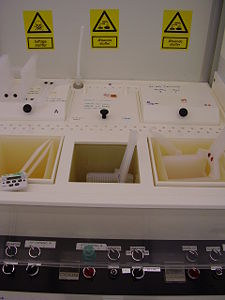Specific Process Knowledge/Etch/Wet Polysilicon Etch: Difference between revisions
| Line 11: | Line 11: | ||
HNO<sub>3</sub> : BHF : H<sub>2</sub>O 20 : 1 : 20 | HNO<sub>3</sub> : BHF : H<sub>2</sub>O 20 : 1 : 20 | ||
===Poly Etch data=== | |||
=== | |||
{| border="1" cellspacing="0" cellpadding="4" align="left" | {| border="1" cellspacing="0" cellpadding="4" align="left" | ||
Revision as of 12:58, 30 January 2008
Wet Poly Etch

The wet Poly Etch is an isotropic silicon etch. This holds for both a poly-silicon thin-film as well as single-crystalline material such as a Si(100) surface. The Poly Etch process is placed in a dedicated PP-tank in a laminar-flow bench in cleanroom 4.
The Poly Etch is typically used for opening holes in poly-silicon thin-films, using photoresist as an etch mask. Due to its isotropic nature the under-etching (etch-bias) at least amounts to the thickness of the poly-silicon layer. Another example of usage is etching of "circular-shaped" holes in silicon substrates.
The Poly Etch is based on the combined oxidation of silicon followed by dissolution of the silicon oxide. The etch solution consists of:
HNO3 : BHF : H2O 20 : 1 : 20
Poly Etch data
| Nitride etch @ 180 oC | Nitride etch @ 160 oC | |
|---|---|---|
| General description |
Etch/strip of silicon nitride |
Etch/strip of silicon nitride |
| Chemical solution | H3PO4 (85 wt%) | H3PO4 (85 wt%) |
| Process temperature | 180 oC | 160 oC |
| Possible masking materials: |
|
|
| Etch rate |
|
|
| Batch size |
1-25 wafers at a time |
1-25 wafer at a time |
| Size of substrate |
2-6" wafers |
2-6" wafers |
